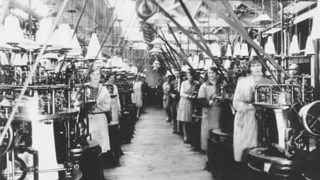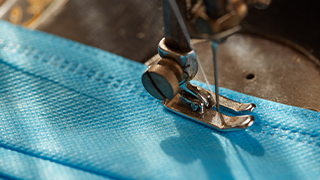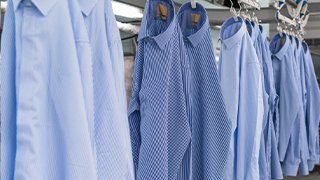Sock Manufacturing & Inspection
Sock Knitting Overview
Sock knitting machines are highly specialized circular knitting machines specific to the products made on them. These machines can use any type of yarn or fiber to produce hosiery and socks made to shape, size, and performance criteria.
Machine Components
The principles of circular knitting are the same whether the yarn supply, or creel, is at the side or top. Fed from above the knitting elements, yarns move from the creel through guides to stop-motion controls above the machine, then back down through tension controls and yarn-feeding devices to the knitting elements. High-quality products can be produced only when stop-motion and yarn-feeding functions are set properly. The intricate action of knitting—where needles form loops—occurs in the middle of the machine, between the take-up and the yarn-feeding mechanism. In circular weft knitting, needles knit one after the other in sequence, and loops are formed horizontally by needles knitting around the cylinder, forming a tube.
Knitting Cylinder
On a single-cylinder machine, the cylinder, with its vertical needles, can make all the stitches needed for sock manufacturing.
The machine’s components are the cylinder, the needles, the sinkers, and the dial with transfer bits or jacks.
Knitting Needle Cycle
A sock knitting needle must form a new loop, pull this loop through the previous loop formed, lose the old loop, and pull the new loop to the length specified for the product. Variations in this cycle allow fine-tuning of texture, appearance, and performance to meet product specifications.
Part 1
Part 2
Machine Types
Sock fabrics can be made on more than one set of needles. Double-knit fabrics are produced from two sets of needles. Some sock machines have two cylinders, one positioned above the other, to produce constructions such as links-links.
Other machines are specialized to add reinforcement, formed pockets, terry surface on the inside of the sock, and other innovations.
Part 1
Part 2
Part 3
Sock Components Overview
Whether socks are designed for function or fashion, most socks share the same basic components: the top or welt, leg, heel, foot, and toe. Each component can be altered or enhanced to meet end-use specifications.
Welt Formation
The welt is very important because it is the starting point of the sock and provides an edge that will not ravel. It is important to fit, and it may be seen, depending on the sock design. If the welt is a single jersey base, a dial is mounted concentrically with the cylinder and rotates with it. The dial contains transfer points or jacks that engage the beginning courses of the sock and hold them until sufficient fabric for the welt has been knitted, whereupon the transfer points return the fabric to the needles.
Heel Pocket Formation
A key aspect of a well-fitting sock is the formed heel. Sock machines are designed to allow for the knitting of extra fabric in the shape of a heel. This type of heel is referred to as a “heel pocket.”
Toe Pocket Formation
As with the formed heel, the best-fitting socks have a toe pocket. Yarn selection and reciprocation of the cylinder are important for toe-pocket formation. Also, having more courses in the bottom of the toe than in the top of the sock will result in the toe seam being on top of the toes, which provides better comfort than having the seam at the end of the toe or under the toes.
Cushioning
A common component of socks is a cushioned sole. Terry loops can be added throughout the sole to provide cushioning for the foot. An added benefit of terry is improved wicking of moisture from the skin.
Reinforcement
A reinforcing or splicing yarn is frequently used to form a heavier fabric in the parts of hosiery that are subjected to the greatest wear. These areas are the portion of the ankle above the heel, commonly called the “high heel” or “spliced heel,” and the sole, referred to as a “double sole.”
Patterning
Patterning, or the design of socks, is based on costs, end use, and fashion. Commodity socks tend to use single patterning of the knitted stitch and are primarily single jersey throughout the sock, with a stretch yarn in the leg portion. The benefits of including stretch yarns in the leg portion are to help hold the sock up and to attain knitted rib appearances without having to knit on a cylinder-and-dial machine. Cylinder-and-dial machines or double-cylinder machines offer more pattern capabilities.
Texture Effects
Texture effects can be achieved in various ways, affecting the sock’s appearance, performance, and cost. Various types of textured yarns are available. Synthetic yarns may have high bulk and stretch properties, and spun yarns may be made with varying yarn diameters. Single-spun, plied, or wrapped yarns may be used alone or in addition to textured yarns. The use of tuck and float stitches can further accentuate the texture. Finally, the manipulation of the needles by omission or needle transfer, as in the links-links stitch, can achieve diverse desired effects.
Yarn for Socks
Many types of yarn, of either natural or synthetic fibers, can be used for sock manufacturing. Either stretch or non-stretch (“hard”) yarns can be used. In most socks, stretch yarns are used for better fit and performance. The yarns also be dyed or undyed.
Sock Stitch Formations
Stitch Counts
The structure of the sock fabric consists of loops arranged in rows and columns. A horizontal row of loops, produced by adjacent needles during the same knitting cycle, is known as a “course.” The “course count” is the number of courses per unit length (inches or centimeters). The vertical columns are known as “wales,” and the “wale count” is the number of wales per unit length.
Types of Stitches
The design of the sock and its fabric depends on the basic stitches that make up the product. Only three types of loops or stitches are possible in sock manufacturing: knit, tuck, and float. In addition, stitches can be transferred or split to create useful or aesthetic designs.
Dyeing & Finishing Overview
The dyeing and finishing of socks is very similar to that of other apparel products. Many socks are made with dyed yarns or fiber and do not need further dyeing. Finishing processes for socks are not as varied as for other apparel products, but are still important.
Rotary Drum Machines
Rotary drum machines are commonly used in sock dye houses. These machines use low levels of water, energy, and chemicals and offer fast processing times. On-board computer systems allow for automated control of processes, including the addition of the chemistry. Modern rotary machines can also centrifugally extract the goods after wet processing.
Paddle Machines
Paddle machines consist of a revolving paddle wheel that sits in an open vessel filled with water or a processing liquor. As the wheel turns, the vanes dip down into the bath and cause the water to tumble inside. Socks are forced to move under the vanes, which causes them to tumble in the bath. These simple machines are capable of processing large poundages, are especially useful for scouring and bleaching, and are easy to load and unload. However, they are not the best choice for dyeing, because of the large amounts of water used, the energy needed to heat the water for the dyeing process, poor agitation of the socks, a longer cycle time, and their inability to extract the goods.
Extraction
Once wet processing is complete, the socks are extracted to remove excess water through centrifugal force, which minimizes drying time and energy use. Modern rotary machines have excellent extraction capabilities, which are often sufficient for drying without external extraction steps. Older rotary and paddle machines require a separate extraction in a machine designed specifically for that purpose.
Dryers
Sock dye houses use tumble dryers almost exclusively. In addition to removing water, tumble dryers tumble in bulk and relax the socks, resulting in very low shrinkage characteristics. The technology ranges from stand-alone machines to tandem operations connected to the washing and dyeing machines.
Continuous Scour & Bleach
In many modern sock dye houses, continuous tunnel ranges are used for scouring and/or bleaching. The advantages of these machines are that they are continuous in operation, require fewer operators, and can process large quantities of socks in a given production period.
Dyeing
Color can be applied to socks in fiber, yarn, or garment form. All dyestuffs used in piece-goods dyeing of various fibers can be applied to socks. Before the yarn or socks can be dyed, they must be prepared, to remove any unwanted materials. Cotton socks need to be bleached before dyeing to remove their natural off-white or cream color.
Finishing
“Finishing” is defined as any chemical process other than preparation or the application of color that imparts useful or desired properties to a textile or apparel product. Finishing usually occurs after the sock has been prepared and dyed, and is often the last step.
Boarding
After knitting and wet processing, socks normally are hot-pressed into the two-dimensional shape of a lower leg and foot, in a process called “boarding.” Various technologies are used for boarding, but all involve the use of a boarding form, steam, heat, and pressure. Boarding of cotton socks is a method of pressing for packaging and shape retention. For blends containing stretch fibers, such as spandex, or thermoplastic fibers, such as nylon or polyester, the boarding temperature can be high enough for heat setting, which will give the sock a memory for the shape in which it is boarded, reducing shrinkage.
Socks are inspected primarily during knitting and packaging operations.
Management and quality-control personnel and line knitters inspect the socks during knitting, and some culling of defective socks takes place during toe closing and boarding.
Fit
A sock’s fit depends on proper sizing, which in turn is based on proper stretch and recovery. This is arguably the sock’s most important performance characteristic. Poor stretch results in poor fit and performance shortcomings. Fit is determined with the appropriate NAHM foot form.
Stretch
A “statistically sound” stretch machine should be used to document standard stretch dimensions. Socks are stretch-tested with an apparatus that can measure and record lengthwise and crosswise stretch at a specified load.
Abrasion Resistance
Socks often undergo abrasion testing. Historically, abrasion testing has not been very reliable, with limited repeatability. Better results are obtained with Martindale and Stoll abrasion testers.
Pilling
The Random Pill Tester is designed to determine whether a fabric sample has a propensity to form pills on the surface. Pills are small balls of entangled fibers attached to the surface of a fabric by an anchor fiber. Because many socks are made with large, low-twist yarns for softness, and because many socks use blends of fibers, they are likely candidates for pill formation. The high strengths of synthetic and wool fibers make them more likely to pill, and these fibers serve as anchors for pill formation.
Strength
Although strength is not typically a problem in socks, the bursting strength test is always specified for sock products.
Crocking
The test for crocking determines whether a fabric will transfer color to a standard white test sample. The test is run with both dry and wet fabric.
Lightfastness
Colorfastness to light is important for socks. Lightfastness tests determine how much the color will fade when the sample is exposed to a standard light source, which is usually a carbon arc or xenon lamp.
Colorfastness
Colorfastness to laundering is tested by an accelerated method that approximates three to five home launderings with detergent. It determines the degree of color change or staining during home laundering.


